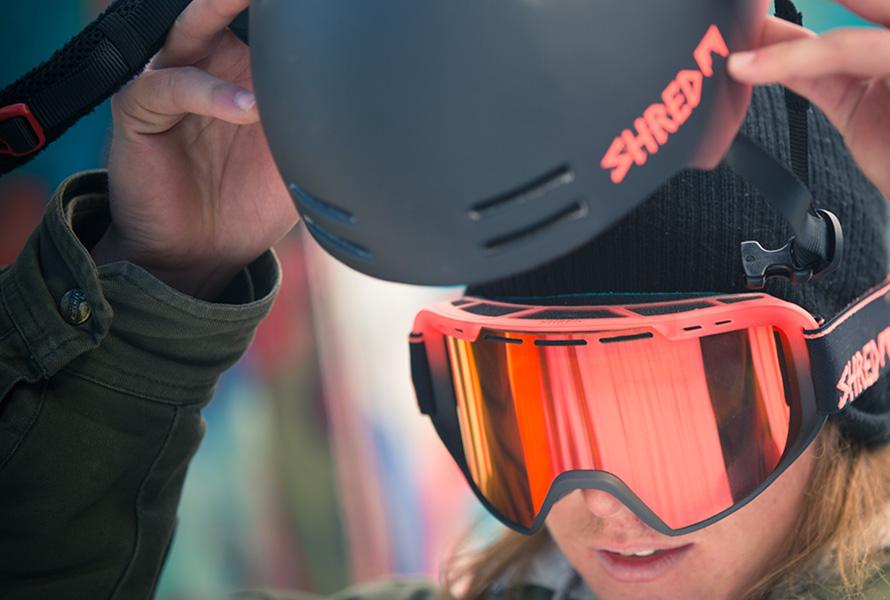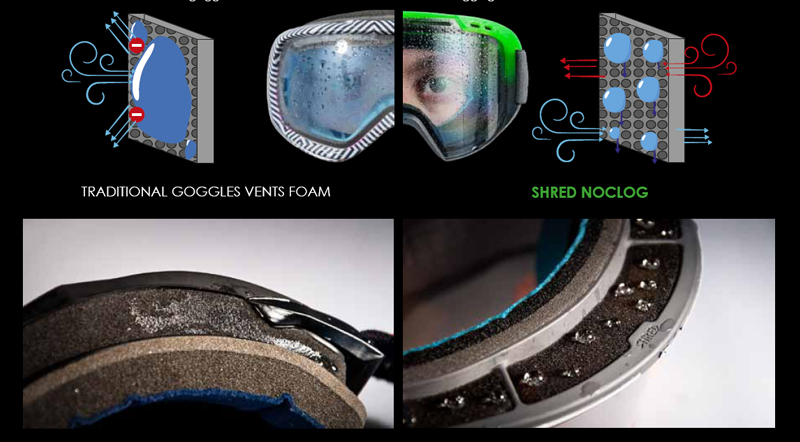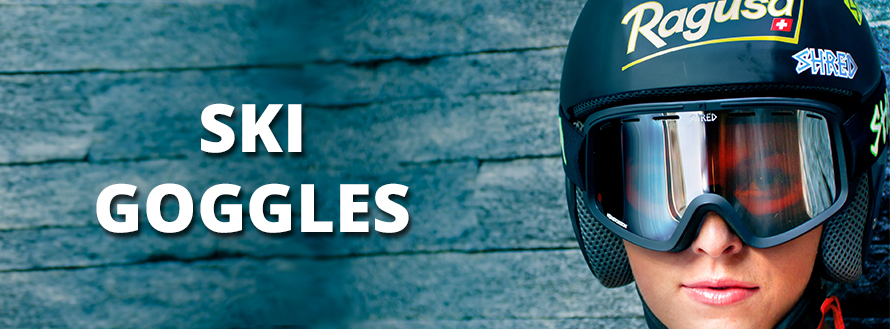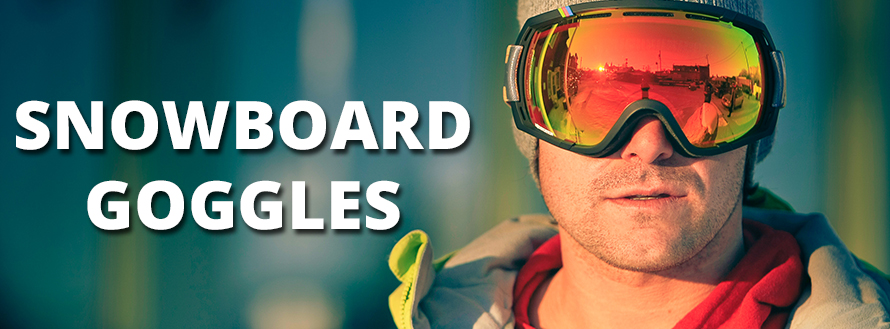How to choose new snow goggles?

Goggles are one of the most important pieces of equipment you can buy. They are just as important as choosing right jacket and pants. Any skier or snowboarder can tell you that not being able to see bumps or icy track, as bad as poor fitting ski boots. Almost all of ski and snowboard goggles will offer some basic protection from wind and cold, but beyond the basics there are some key features you should consider: lens colour, lens type, interchangeable lenses, frame size and fit...
Goggle LENSES
The biggest differentiator between goggles is the lenses. We will make it easy by breaking them down into lens type, lens color, and other features from fog prevention to glare protection.
Single lenses: less commonly found, these are lighter than double lenses by a small amount and cheaper. Single lenses fog up quicker than double lenses, so need to be coated with a fog resistant layer.
Double lenses: More expensive than single layered lenses these are sealed during construction to put a barrier on internal fogging.
Cylindrical (flat) lenses: the surface of the lens is flat. Lower priced, these are better for budget buys. Flat lenses offer the peripheral vision.
Spherical Lenses: the surface of the lens has a vertical curve. These cost more than flat lenses. They give better peripheral vision Spherical lenses tilt away the sun’s glare for less distortion.
Lenses can be purchased with filters that help change the way you see as you ski. Different tints allow you to get a better view to suit your surroundings. The amount of light that reaches your eyes through the goggles is important, and is measured in as VLT, or visible light transmission.
Darker lenses in greys and browns have a lower VLT, whereas lighter lenses in blue and pinks have a higher VLT. Most ski goggles come with interchangeable lenses so you can adapt your VLT to your environment and conditions, whilst more expensive photochromic goggles adapt themselves to UV light. For Bright , Sunny Conditions: Dark or Fume Lenses are needed. You need more visibility so the light can ‘bounce back’ for excellent levels of distance judgement, with less light coming into the lens. You can also choose Polarized Lenses, which cut back on glare.
For Foggy Conditions/Poor Visibility/Flat conditions: Lighter lenses are needed. Lighter lenses are used so more light can enter the goggles. You need more depth perception and contrast and the ability to see shapes in the darker areas: pink, red, yellow, amber, blue
Clear Lenses: at Night: You need the maximum light possible: No tints are needed. No tints are used so the maximum light can enter the goggles.

Lenses technologies:
UV Protection : almost all new goggles, even at the lower end of the price spectrum, have 100% UV protection. UV intensity increases with altitude, and protecting your eyes from harmful UV rays will prevent eye fatigue as well as damage to your retinas.. UVA and UVB are the most important rays to guard against. Too much exposure to UV on a short-term basis can give you a painful sunburn on your eyes, called photokeratitis. Long-term, UV rays can damage your eyes permanently and may lead to cataracts and other eye diseases. Look for goggles and sunglasses that block 100 percent of these rays, which bounce off the snow and into your eyes even on cloudy days.
Polarized Lenses: reduce glare by blocking out all angles of scattered and reflected light from surfaces such as snow and water. The polarization process eliminates light that distorts color and enhances depth perception and vision. The result is a clean lens that delivers proper clarity and contrast and achieves the optical perception. When light is reflected off certain surfaces, it tends to be reflected at higher intensity through angles perpendicular to the surface. By acting as a filter of vertical light, polarized lenses are able to cut glare much more effectively than a standard mirrored lens while improving overall visual clarity and providing increased contrast and definition. Polarized lenses are great for snow sports and reduce eye fatigue and strain.
Photochromic lenses: these lenses automatically change their tint level according to conditions and UV intensity. The more sun and UV rays, the darker the lenses become. If it's snowing or overcast the lens stays lighter. Indoors, they always stay light no matter the light intensity.
Mirrored lenses: mirrored lenses have a partial or full lens coating on the outside of the outer lens. A coating on the outside of the goggle lens reflects a greater amount of light than a non-mirrored lens. Letting in a decreased volume of light means less glare and increased visual clarity in bright conditions.
Anti-Fog Coating: a hydrophilic chemical treatment to the inside of the lenses can greatly reduce a goggle’s tendency to fog. Some coatings are more durable than others. Be sure to read the manufacturers’ directions because poor goggle care can lead to wiping off the anti-fog coating.
Ventilation: you can count on virtually all quality goggles having vents, but some are better than others. In general, more venting is better in terms of preventing fogging. It is important to check that the venting system in your goggles is compatible with the shape of your helmet, in other words don’t block the vents.
Goggle FRAME
While goggle frames come in a different sizes and shapes, they basically have three jobs: hold your lens in firmly, keep snow out of it and make your face as comfortable as possible:
Frame Size
Many adults can comfortably fit into multiple sizes of goggles, but here are some general guidelines. A simple way to think about frame size is that it often times correlates with the size of your head so if you wear a small helmet consider a small frame and if you wear a large or extra-large helmet consider a larger frame, medium to large helmet consider a medium frame size.
Face Foam - Make sure the foam follows the curvature of your face without pressure points. There should be no gaps between the foam and your face for wind or snow to flow through. You want a consistent, snug fit all around the perimeter of the goggle. If the goggles pinch your face or feel uncomfortable, they probably aren’t for you.

Helmet Compatibility - When checking your goggle fit, make sure that they work with your helmet for performance and aesthetics. Your goggles should fit smoothly on your face with the strap around the helmet. If they don’t fit tightly to your face, or deform when the strap is tight, try another model. Most goggles are helmet-compatible, but some of the larger spherical goggles may have compatibility issues and a goggle that’s too small may leave GAPS.
Goggle Care
Here are some basic tips if you want to protect goggle in order to ensure that they last as many seasons as possible:
Never let your lens touch the table or hard surface when you set them down. Place them on the foam side with the lens facing up.
Use only a soft cloth (not your baselayer shirt) or anti-fog cloth to blot (not wipe) the goggle lens dry. Wiping is more abrasive and can remove the anti-fogging coating on the inside of the lens. When off the slopes allow goggles to air dry thoroughly before stowing in their bag. Store your goggles in a soft sack when they are not in use. Most come with one when purchased. Do not dry goggles in direct sun or high heat, such as on the dashboard or hanging from the rearview mirror.
Tips to Avoid Fogging
Is your goggle always fogging up? Here are some tips to keep your goggles working as efficiently as possible:
The airflow you get from riding keeps fog from forming, so keep moving. Remove excess snow from the goggle by shaking them. Don’t wipe the lens with your gloves, as your glove is abrasive and can leave your lens scratched. Clear snow off of vents so they are clear. Avoid putting your goggles on your forehead. They will fog up. If you goggles do get fogged up, place them in a warm, dry pocket of your jacket. You can also try shaking them up and down to create air flow. If need be, go into the lodge to dry them out. This is another great reason to carry two pairs of goggles.
Ski goggles:
Snowboard goggles:















